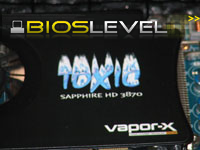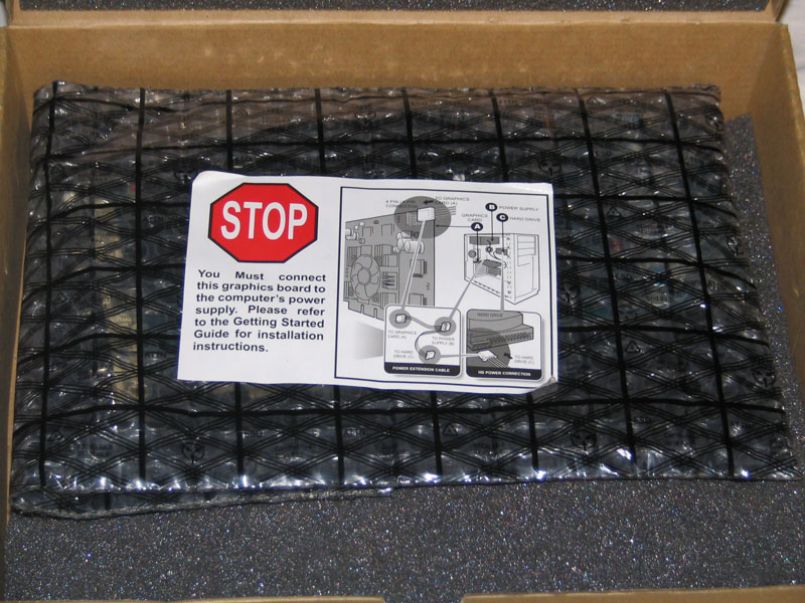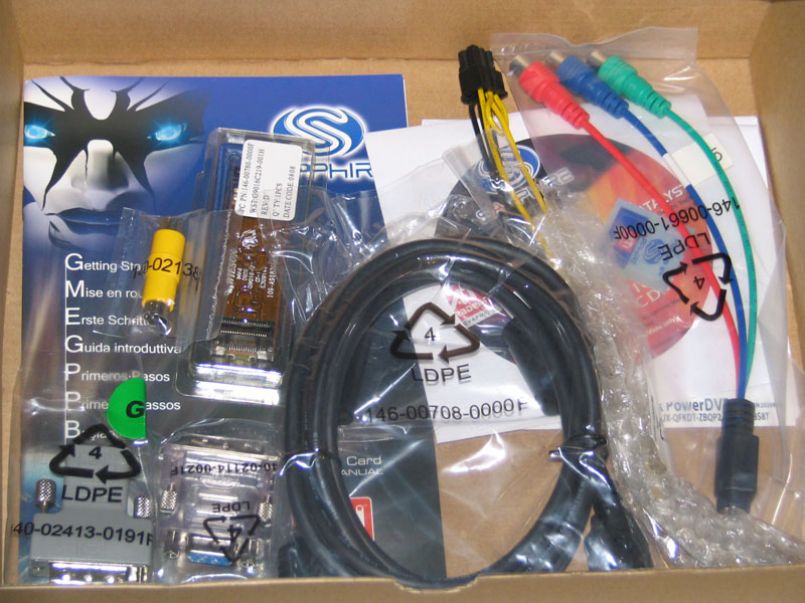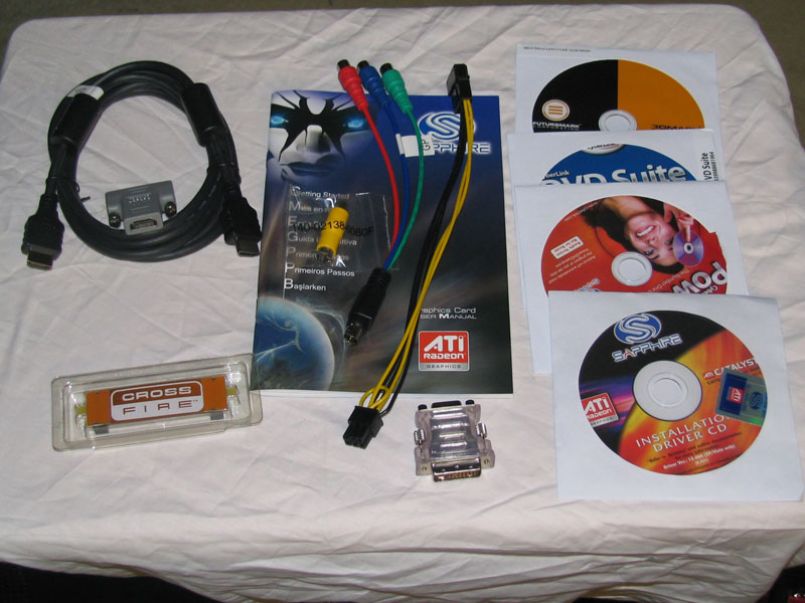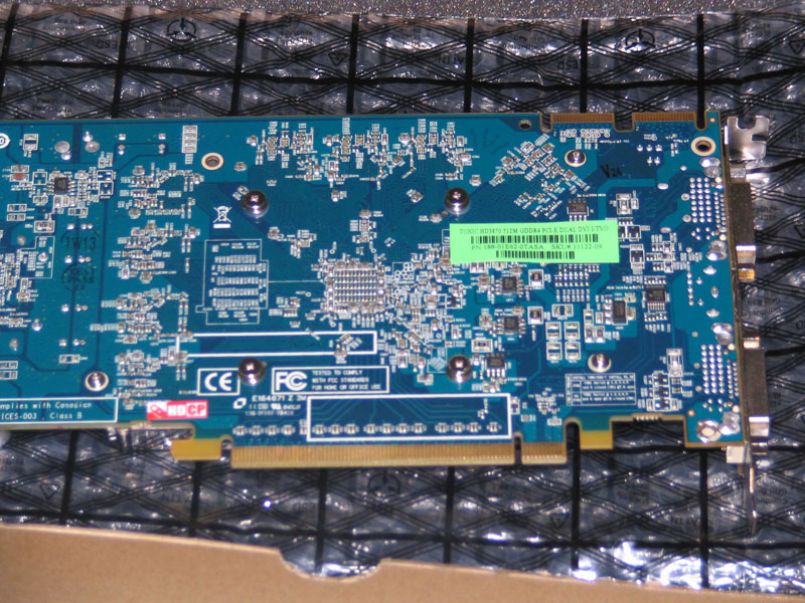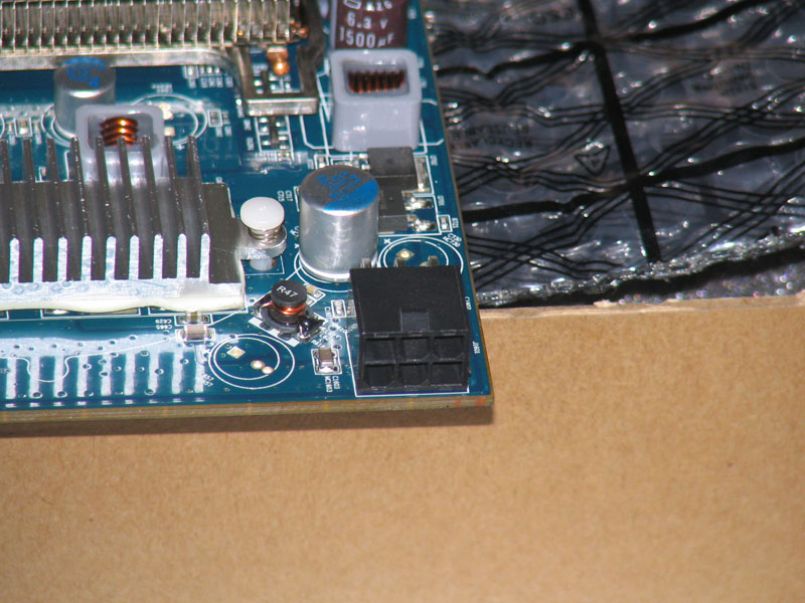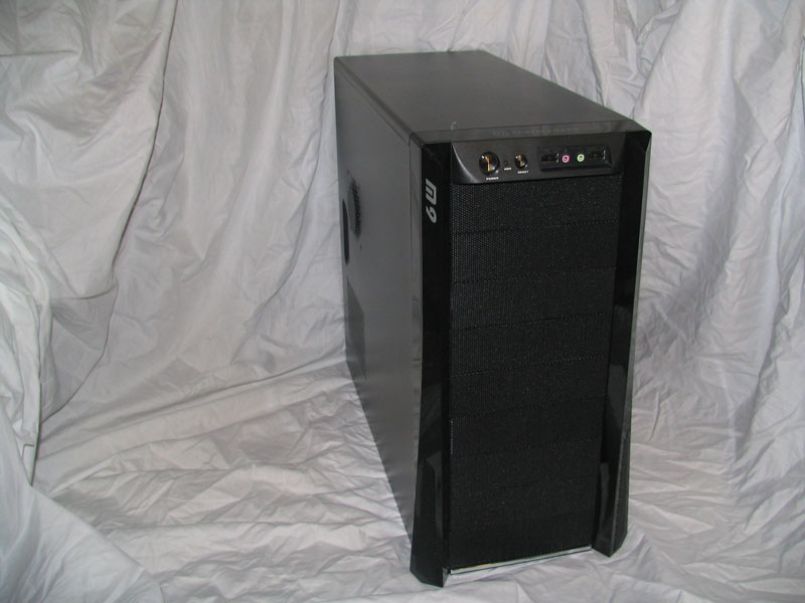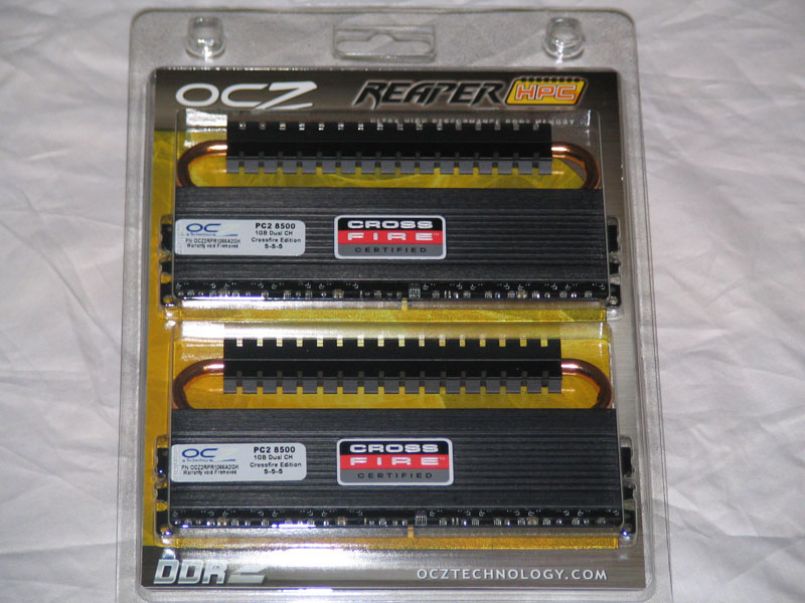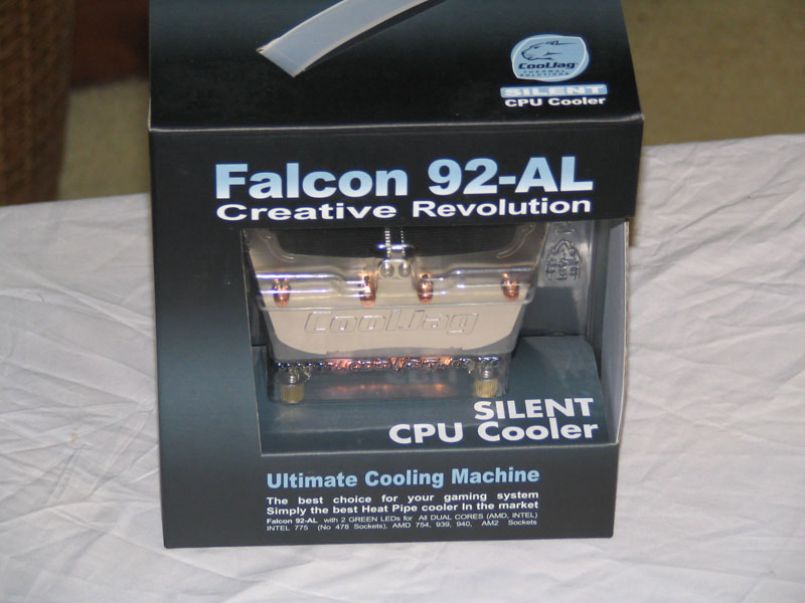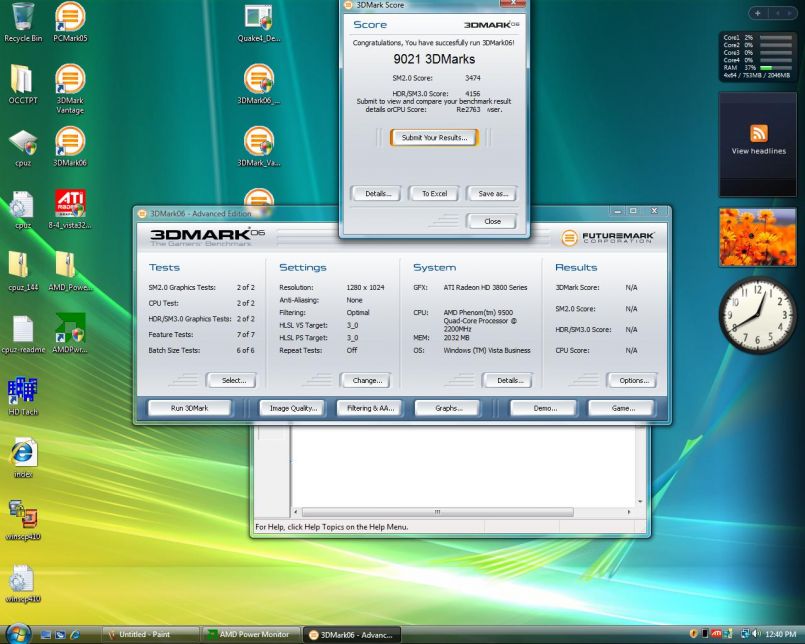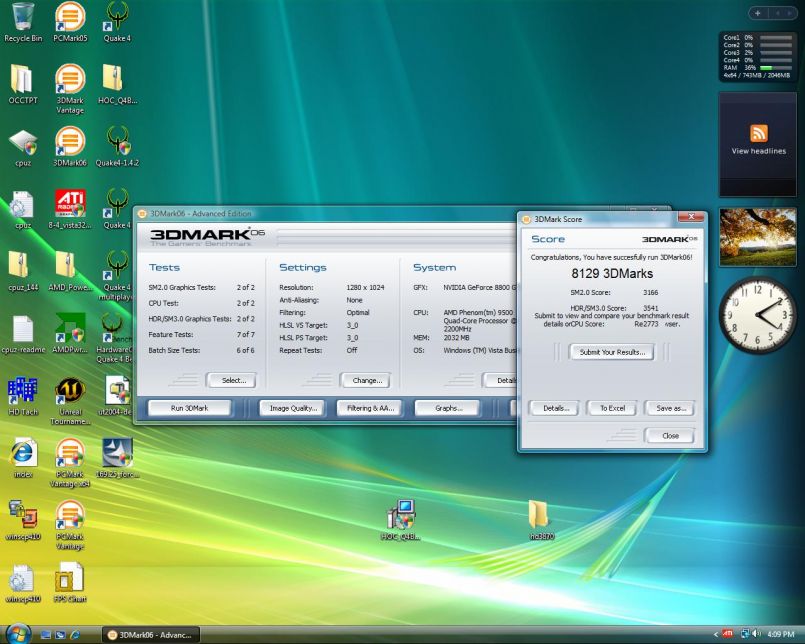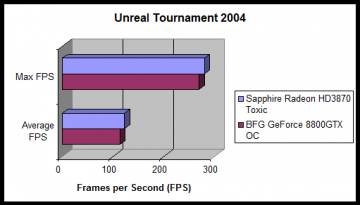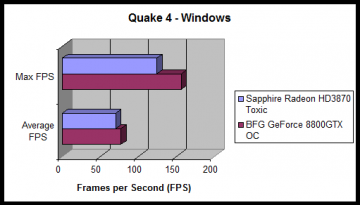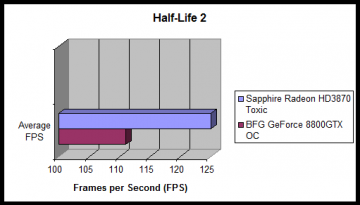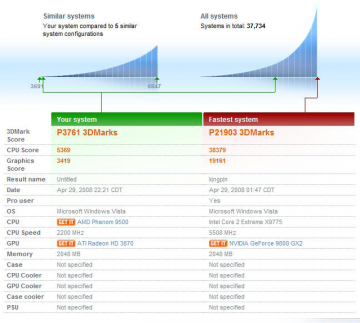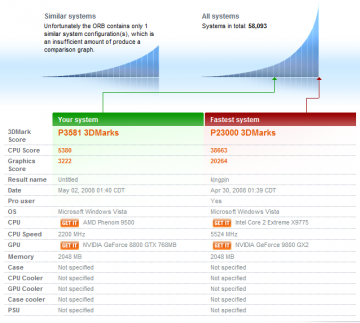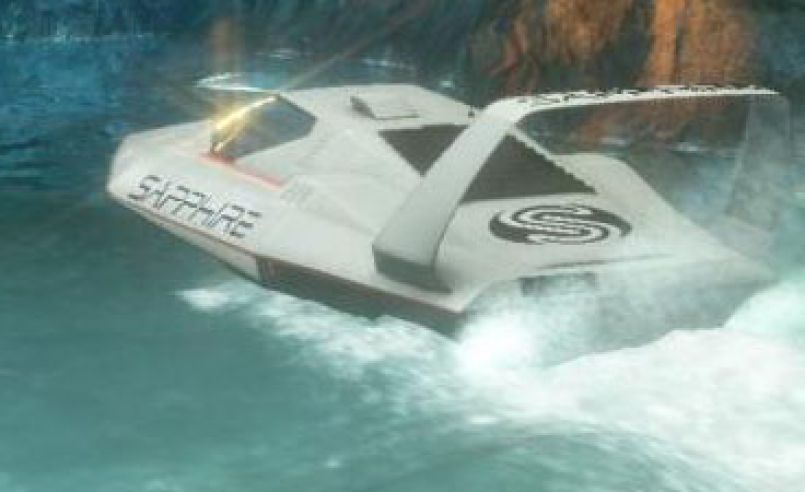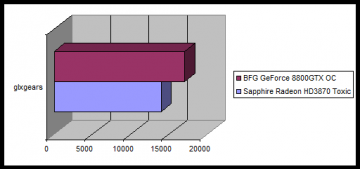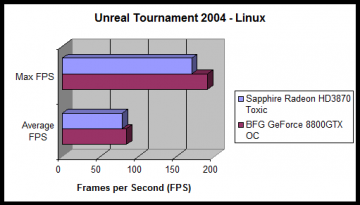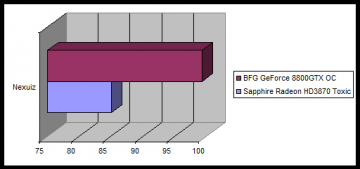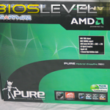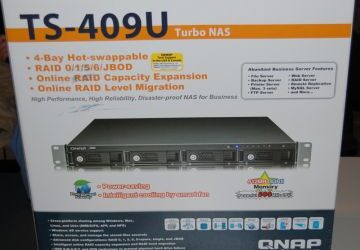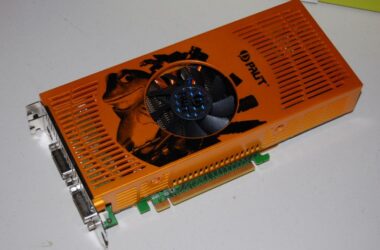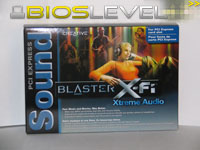Introduction
The two big players in discrete graphics these days are nVida and ATi. nVidia won the performance crown with the release of the 8800-series in late 2006. ATi, now owned by AMD, released the new HD-series of Radeons. Sapphire was nice enough to send us the Radeon HD3870 TOXIC edition for review.
The HD3870 features the latest PCI-Express 2.0 technology, which doubles the original specification's available bandwidth. The card is also bundled with 512MB of GDDR4 memmory clocked at 1152MHz, and a core clock of 800MHz. To keep the card's form factor to a single expansion slot, Sapphire developed the Vapor-X cooling solution, which utilizes heatpipes to transfer heat from the GPU to the cooling fins faster than traditional GPU coolers.
Specifications and Features
Before I get to the card itself, I wanted to find out exactly what kind of hardware I was dealing with. As I said before, the card features the latest PCI-Express 2.0 interace, doubling the bandwidth of the previous generation of PCI-Express. The GPU of this unit is built on a 55nm process and features 666 million transistors, which is roughly 200 million more than AMD's latest Phenom CPU has. The GPU features a unified architecture, providing faster performance and DirectX 10.1 support with Shader Model 4.1.
The Unified Architecture provides 320 stream processing units, which enables parallel processing much like a multi-CPU computer. Aside from superb texture rendering and anti-aliasing capability, the card also delivers physics processing support with the Havok physics engine.
Pairing with the GPU and PCI-Express 2.0 interface is a 256-bit GDDR4 memory interface, providing more than enough bandwidth for graphic-intensive applications such as 3D rendering and gaming. The Toxic ships with 512MB GDDR4 RAM standard.
While the card supports DirectX 10.1, it also supports OpenGL 2.0, which should aide performance under Linux and Windows OpenGL games. The card also supports ATI's Avivo HD Video and Display platform, which enables video decoding acceleration for the MPEG and DivX video formats, along with great control over colors, gamma, and conversion/scaling of video.
On the rear of the card are two DVI ports and a single S-Video output. The Radeon HD3870 supports up to two displays, each capable of running at it's own resolution up to 2560×1600. The DVI ports are also capable of HDMI transmission with an adapter, and the cards is HDCP compliant, enabling playback of digital content such as Blu-Ray and HD-DVD over HDCP compliant displays. The HDMI connection also supports multi-channel AC3 audio support, meaning the HD3870 also has it's own sound engine.
The HDMI connection supports displays up to 1920×1080 in resolution, and the integrated AMD Xilleon HDTV encoder is able to output high-quality HDTV and SDTV pictures.
To meet the demands of those seeking "green PCs" and lower power bills, the HD3870 Toxic features ATI PowerPlay for throttling speed based on usage and temperature.
One of the biggest selling points of the Radeon HD3870 is support for CrossFireX, which allows you to scale from two to four GPUs for incredible performance. CrossFire bridges are required between the cards, as well as a matching number of PCI-Express x16 slots, but the performance gain should be more than enough to attract those with the currency.
Enough with the product specifications. A full list can be found on Sapphire's product page for the Radeon HD3870 Toxic. I want to get the card out of the box.
Packaging
The Toxic's packaging isn't unlike many other video card boxes you can pick up these days, with the exception that it holds Sapphire's own customizations. The thing that stands out the most to me is silver avatar, which kind of reminds me a bit of the Silver Surfer from Marvel comics. Below him are the Toxic's main features: PCI-E Version 2, DirectX 10 support, Shader Model 4, HD Video Decoding, and 5.1 Surround Sound.
To the right of the avatar are more features and bundled software, such as Sapphire's Vapor-X technology, a coupon for Valve's Half-Life 2, Portal, and Team Fortress 2, HDMI Support, and ATI's latest CrossFireX support.
On the rear of the box are descriptions of the various features mentioned on the front, along with a full product description and the box's contents. I hope the card is in this box!
Upon opening the box, I was greeted by some hard foam protecting the card itself. The card is wrapped up in some extra-durable bubble wrap with a sticker warning about proper installation methods.
Under the card were numerous accessories: CrossFire connectors, HDMI adapters and cables, an s-video adapter, component video cables, the instruction manual, and packaged software CD's.
Now it's time to pull the card from it's sheathe and install it in our test system.
Appearance
The Toxic measures up to be almost the same size as the nVidia GeForce 8800GTS at 220mm ×100mm, but is much shorter than the 8800GTS' 33mm height since the HD3870 Toxic only requires a single expansion slot.
The Vapor-X cooler is miniscule in comparison to the dual-slot coolers on competitor's HD3870 models. It's decorated with the Toxic Logo and model number, as well as the Vapor-X technology logo.
The Radeon HD3870 Toxic is powered by a single 6-pin PCI-Express connector, as the power from the PCI-Express x16 slot isn't sufficient.
Next, I look at our test system.
Test System & Installation
For this review and future reviews, several companies were kind enough to send us products to assemble a full machine. Sapphire sent us the Radeon HD3870 Toxic, as well as the PI-AM2RS780G 780G chipset motherboard, and an additional Radeon HD3450.
AMD was kind enough to sponsor us with two CPUs, the Athlon64 X2 5000+ and Phenom 9500. OCZ sent a 2GB kit of DDR2 PC2-8500 Reaper HPC CrossFire Certified Edition RAM. Thermaltake sent the M9 chassis to house the components, and Excelstor provided a 250GB hard drive.
Cooljag also sent two CPU coolers for this review, but due to the close proximity of the southbridge heatsink to the CPU clips we were unable to utilize these coolers in this review.
To power the system, I opted to use the StarTech.com WattSmart 750W Power Supply I previously reviewed. Finally, we will be using Ubuntu 8.04 as well as Windows Vista 64-bit Business edition to benchmark the Radeon HD3870 Toxic. Let's look at our final setup:
| Processor | AMD Phenom 9500 | |
| Motherboard | Sapphire PI-AM2RS780G 780G | |
| RAM | 2GB DDR2 PC2-8500 Reaper HPC CrossFire Certified | |
| Video Card | Sapphire Radeon HD3870 Toxic / BFG GeForce 8800GTX OC | |
| Chassis | Thermaltake M9 | |
| CPU Cooling | Xigmatek HDT-S1283 | |
| Hard Drive | Excelstor 250GB SATA2 | |
| Power Supply | StarTech.com WattSmart 750W Power Supply | |
| Display | 1280×1024 | |
We are very greatful to all our sponsors, and we ask readers to stay tuned for individual reviews of these components in the upcoming weeks.
Installation was simple, as I only needed to insert the card in to the PCI-Express x16 slot and connect the 6-pin power cable to the card. Running with the 6-pin cable runs the risk of damaging the card, as well as reduced performance. Sapphire included a dual-molex to 6-pin adapter for older power supplies.
I opted to get the latest drive from AMD's website, rather than use the driver off the CD. Chances are, the videocard was packaged before Catalyst 8.4 was released.
Windows Benchmarks
Since I'm using Windows Vista 64-bit Business Edition, I'm expecting to see slightly lower numbers that what many of our affiliates and related sites post for similar hardware. There are few games, drivers, and operating systems fully optimized for 64-bit computing, and thusly we see many performance hits. However, as 64-bit becomes more and more mainstream, our results here will prove to be much more realistic to newer PCs shipping with 64-bit operating systems.
Our benchmarks for this system will consist of Futuremark's 3dMark06 and the new 3dMark Vantage, Unreal Tournament 2004, Unreal Tournament 3, and Quake 4, and Half-Life 2. Unreal Tournament 2004 and Quake 4 both have native Linux ports, allowing me to directly compare performance between the two operating systems.
AMD released a hotfix to their driver shortly after 3dMark Vantage was released, as there were some cases of image corruption in the first graphics test. The hotfix also includes a few performance increases, as some of the code was meant for the Catalyst 8.5 driver.
Futuremark 3dMark06
Futuremark has yet to released a 64-bit edition of any gaming benchmarks, so I was expecting to see low numbers using this setup in a 64-bit environment. 3dMark06 was run with default settings with all tests selected.
I was somewhat dumbfounded to see the HD3870 Toxic score nearly 1000 points higher than the 8800GTX. Similarly, I found it strange that the CPU score suffered during the transition from the HD3870 Toxic to the GeForce 8800GTX.
Unreal Tournament 2004
Unreal Tournament 2004 was the oldest game we used to benchmark this system. The game may be a little older, but is still one of the most popular first person shooters, even after the release of it's successor. Additionally, UT2004 is one of the first games to have a native 64-bit port. We ran a simple bot match with all the settings on high. To run the botmatch and record our desired results, we used to following command line options: ut2004 dm-rankin?spectatoronly=1?numbots=12?quickstart=1?attractcam=1 -benchmark -seconds=77 -ini=default.ini
As the graph shows, the HD3870 Toxic comes out on top in both max FPS and average FPS. Neither card at any given point spiked below 40FPS, meaning the game is fairly smooth regardless of which card is used.
Windows Benchmarks, Continued
Quake 4
Quake 4 features a slightly newer and more advanced engine than Unreal Tournament 2004. Even after Quake 4 was released, two more games were released using the same, yet upgraded, engine: Enemy Territory: Quake Wars, and Prey. The initial release of Quake 4 saw a FPS limit locked at 60FPS, but subsequent tweaks and patches have successfully removed this cap. The benchmark was run using the HardwareOC Quake 4 Benchmark utility. Graphics were set to the max, and symmetric multiprocessing was enabled to take advtanged of all four cores of the Phenom.
Both cards, on average, were far past the 60FPS Quake 4 was originally limited at. The 8800GTX pulls a little farther ahead in this game, but that could be based completely on the game's rendering engine.
Half-Life 2
Half-Life 2 has some of the most impressive graphics that can be found in games made before Crysis and games featuring the Unreal 3 engine. In addition to fantastic graphics, Half-Life 2 also features great physics, making using of the CPU as well as the GPU.
Half-Life 2 was designed for ATI cards, so it's no wonder that the HD3870 Toxic far outscores the 8800GTX in this benchmark. Before looking at performance in Linux, I want to look at one recently-released game — Unreal Tournament 3 — as well as Futuremark's latest gaming benchmark, 3dMark Vantage.
Windows Benchmarks: Conclusion
Unreal Tournament 3
Epic's latest installment of the Unreal Tournament series is based on the Unreal 3 engine, the same engine that powers games such as Gears of War, BioShock,
and Stargate Worlds. When installed under Vista, Unreal Tournament 3 is able to utilize DirectX 10 for improved graphics and lighting. Like any graphical improvement however, there is a hit on performance, as the graphs below will show.
To benchmark Unreal Tournament 3, I opted to benchmark with varied settings to show the performance differed between the level of detail, as well as DirectX 9 versus DirectX 10. To benchmark UT3, I used ut3bench, which allows me to define my graphical settings and features.
In a game such as Unreal Tournament 3, we see the downside of running a 64-bit OS. The 8800GTX is able to push well over 80FPS with DirectX 10 on a 32-bit system with full system detail. Here, we see both the 8800GTX and HD3870 Toxic performing well under 30FPS, which can't even be called "smooth" performance. Running with the lowest detail possible under DirectX 10, we see a jump in performance for the HD3870 Toxic, far surpassing the 8800GTX this time.
Finally, the maximum performance we can draw from Unreal Tournament 3 is with a lack of DirectX 10 components and a low world detail. Even from this perspective, the framerates don't come close to the performance of a 32-bit operating system. Regardless of this, we see the HD3870 taking the crown in performance.
3dMark Vantage
Futuremark's latest gaming benchmark is the pinnacle of gaming benchmarks and technology, as it may very well bring any setup to its very knees. Through a series of DirectX 10.1, Physics, and CPU tests, 3dMark Vantage measures every ounce of performance that a system is capable of, in every area the latest games utilize.
Unlike 3dMark06, there isn't even a 200 point difference in scores, and the CPU score for the 8800GTX is equal with the HD3870 this time. I would assume this asserts that Futuremark has improved their scoring to account for the fact that only the videocard has changed. Additionally, the benchmark is a 32-bit program, which is again will degrade in performance with a 64-bit operating system, atleast in Vista's case. There is no easy way to discern a clear winner here
In the first demo, the boat initially seen in the benchmark is decorated with Sapphire's logo.
Final Thoughts on Windows
Through the benchmarks I ran, it's hard to declare a true victor between the two cards. Each has it's own areas where one surpasses the other, and in others the difference is hard to discern. The Radeon HD3870 Toxic is the cheaper card, making it the better bang for the buck. Let's hope that it holds on to this crown in Linux.
Linux Benchmarks
Ubuntu's latest 64-bit release —8.04— powered our test machine for the Linux portion of this review. It offered an ease of setup, particularly with the Radeon drivers. Unfortunately, at the time of this writing, version 8.4 of the Catalyst drivers had yet to make it in Ubuntu's repositories. Therefor, a manual install was necessary, but simple.
glxgears, a controversial benchmark?
When people complain of poor glxgears performance, it may or may not give a good idea of how your graphics card will perform in games. glxgears may very well report several thousand frames per second, and yet your gaming performance will be horrendous. This typically falls under the category of Xorg configuration, but it could be any number of things. Thankfully, we didn't run in to this issue.
As I suspected, the HD3870 Toxic was beaten by the 8800GTX. It's been common knowledge that the nVidia driver performs much better in Linux than ATI's. Many improvements have been made to the ATI driver since AMD bought ATI, but there is still much performance left to be desired.
Unreal Tournament 2004
I installed the 64-bit edition of Unreal Tournament 2004, much like in Windows. I applied the previously mentioned command line options to the Linux binary through a simple shell script, then ran the benchmark.
Much like glxgears, the HD3870 Toxic was overtaken by the 8800GTX, but only slightly. Neither card performed quite where it's Windows counterpart did, but there's more than enough performance for a very smooth game experience.
h3>Linux Benchmarks, Continued
Quake 4
Quake 4 is also another game with a native Linux port, making it easy for us to compare results with the Windows edition. Unlike UT2004, Quake 4 is a 32-bit binary. I wonder how the performance will compare to Windows in this case.
As observed in the graph above, the difference in performance isn't far apart. Nor is performance far from the Windows version of Quake 4. However, we again see the 8800GTX outperform the HD3870 Toxic. I'm suspecting this is an issue with the drivers, and not the actual card.
Nexuiz
Nexuiz is a popular open source first person shooter based on a modified (and very advanced) Quake 1 engine. Phoronix recently release a test suite, consisting of some of the benchmarks they commonly use when benchmarking hardware, and it's all automated through PHP scripts. I opted to run Nexuiz through their benchmark system.
Once again, we see the HD3870 Toxic falling behind the 8800GTX in performance. It does, however, maintain a very respectable and smooth framerate.
Final Thoughts on Linux Performance
Given what performance gains we saw in Windows using the HD3870 Toxic, I feel it's safe to say that the lag the Toxic feels in Linux is a drive issue. Althought AMD has made numerous improvements to the driver, the driver hasn't yet reached a level of maturity where it can openly compete with nVidia's driver.
Regardless, the HD3870 Toxic doesn't fall far behind the 8800GTX in any of the benchmarks. Perhaps in a future version of the Catalyst drivers we'll another performance increase.
Thermal Performance
The temperature of Sapphire's Radeon HD3870 Toxic did not stray from any extremes during the benchmarking process, in Windows or Linux. While the system was idling, the case had an ambient temperature of 38°C, whereas the HD3870 Toxic held steady at 41°C. Under a full load, such as while running 3dMark Vantage, I saw the case temperature jump up to 45°C and the Toxic to 58°C. The card was "cool" enough that I was able to touch the back of the card and the heatsink without feeling like I was going to get burned. Granted, it still felt hot.
Sapphire did an excellent job in designing the Vapor-X cooling solution for the HD3870 series. Unlike with the GeForce 8800GTX's dual-slot cooling solution, I'm able to use the PCI slot directly below the HD3870 Toxic and not worry about the cooling.
Finals Thoughts & Conclusion
Through testing in both Linux and Windows, we found little difference in performance between Sapphire's Radeon HD3870 and the BFG GeForce 8800GTX OC. The Toxic's largest advantage over the 8800GTX is the support for PCI-Express 2.0, which may very well be what gave the HD3870 the edge in some test.
All of our benchmarks were carried out in 64-bit environments, whether Vista Business, or Ubuntu 8.04. The 8800GTX and HD3870 Toxic seemed to be neck and neck in terms of Windows performance, but the 8800GTX took the lead in Linux peformance. I'm attributing this performance gap to ATI's Linux driver. Although several improvements have been made over the last year, there is still something left to be desired.
At $189.99 at NewEgg, the HD3870 is nearly half the price of the $379.99 8800GTX. For as small as the performance gap is between the two cards in Linux, Sapphire's Radeon HD3870 Toxic is by far the best bang for the buck and won't let users down. For this, the Sapphire Radeon HD3870 Toxic Edition earns our editor's choice award.
Pros
- PCI-Express 2.0 Support
- Keeps up with GeForce 8800GTX
- Blazing performance
- Vapor-X technology heatsinks keeps the card cool in a single slot form factor
- Best bang for the buck
- HDCP / HDMI compliant for watching HD movies on HD displays
Cons
- ATI's Linux driver holding performance back




